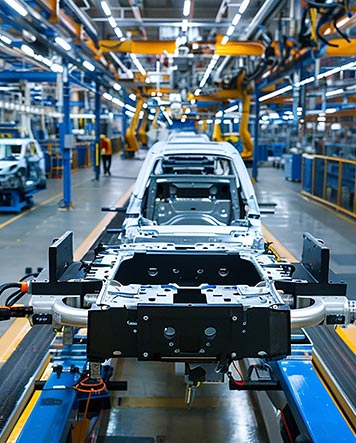The automotive industry is a highly competitive and demanding sector, characterized by high-volume production, stringent quality standards, and constant pressure to improve efficiency and reduce costs. Programmable Logic Controllers (PLCs) and Distributed Control Systems (DCSs) play a crucial role in automating and controlling the complex processes involved in automotive manufacturing. This article explores the specific applications of PLCs and DCSs within the automotive industry, highlighting how these technologies contribute to enhanced productivity, quality, and flexibility.
PLC Applications in Automotive Manufacturing
PLCs are the workhorses of discrete automation in automotive plants, controlling a wide range of machines and processes:
- Body Shop:
- Robotic Welding: PLCs control the precise movements and welding parameters of robotic welding cells, ensuring consistent weld quality and high throughput.
- Material Handling: PLCs manage conveyor systems, automated guided vehicles (AGVs), and robotic arms that transport car bodies and components between different stages of assembly.
- Press Shop Automation: PLCs control stamping presses, ensuring accurate and repeatable forming of metal panels.
- Sealing and Gluing: PLCs control the application of sealants and adhesives, ensuring precise dispensing and consistent coverage.
- Paint Shop:
- Robotic Painting: PLCs control the complex movements and spray parameters of robotic painting systems, achieving uniform paint application and minimizing overspray.
- Environmental Control: PLCs regulate temperature, humidity, and airflow within paint booths, ensuring optimal painting conditions.
- Conveyor Control: PLCs manage the movement of car bodies through the various stages of the painting process (pre-treatment, primer, base coat, clear coat).
- Powertrain Assembly:
- Engine Assembly: PLCs control the automated assembly of engine components, including torque control for critical fasteners.
- Transmission Assembly: PLCs manage the precise assembly of transmission components, ensuring proper gear meshing and functionality.
- Testing and Quality Control: PLCs integrate with testing equipment to perform automated checks on engine and transmission performance.
- Final Assembly:
- Component Installation: PLCs control robotic arms and automated tools that install various components, such as seats, dashboards, and wheels.
- Torque Control: PLCs ensure that fasteners are tightened to the correct torque specifications, preventing loose connections and ensuring vehicle safety.
- End-of-Line Testing: PLCs control automated testing procedures to verify the functionality of all vehicle systems before final inspection.
- Tire Manufacturing:
- Mixing and Extrusion: PLCs control the mixing of rubber compounds and the extrusion of tire components.
- Tire Building: PLCs manage the automated assembly of tire layers, ensuring precise placement and adhesion.
- Curing: PLCs control the temperature and pressure during the tire curing process.
DCS Applications in Automotive Manufacturing
While PLCs excel at discrete control, DCSs are used in areas of automotive manufacturing that require continuous process control and plant-wide integration:
- Paint Shop (Overall Control): While PLCs control individual painting robots, a DCS can oversee the entire paint shop, managing the flow of car bodies, coordinating different painting stages, and optimizing overall paint shop performance. This includes controlling complex environmental systems (HVAC) and managing paint mixing and delivery.
- Centralized Utilities: DCSs often manage centralized utilities that serve the entire plant, such as:
- Compressed Air Systems: Monitoring and controlling air compressors, dryers, and distribution networks.
- Water Treatment: Managing water purification, filtration, and distribution systems.
- Wastewater Treatment: Controlling the treatment and disposal of wastewater generated by the manufacturing process.
- Power Distribution: Monitoring and controlling the plant’s electrical power distribution system.
- Energy Management: DCSs can be used to monitor and optimize energy consumption throughout the plant, identifying areas for improvement and reducing energy costs.
- Batch Mixing (e.g., Paint, Adhesives): DCSs are well-suited for controlling the precise mixing of paints, adhesives, and other materials used in automotive manufacturing. They ensure accurate ingredient ratios and consistent batch quality.
Hybrid Systems and Integration
In many modern automotive plants, PLCs and DCSs are integrated to create hybrid control systems. This allows for the best of both worlds:
- PLC for Local Control: PLCs handle the fast, discrete control of individual machines and work cells.
- DCS for Plant-Wide Coordination: The DCS oversees the overall process, manages centralized utilities, and provides a unified platform for monitoring and control.
- Data Exchange: PLCs and DCSs communicate with each other, exchanging data and coordinating operations. This allows for seamless information flow and improved overall plant efficiency.
- MES/ERP Integration: Both PLCs and DCSs can be integrated with Manufacturing Execution Systems (MES) and Enterprise Resource Planning (ERP) systems, providing real-time data for production planning, scheduling, and inventory management.
Benefits of PLCs and DCSs in Automotive Manufacturing
- Increased Productivity: Automation reduces cycle times, increases throughput, and minimizes downtime.
- Improved Quality: Precise control and automated testing ensure consistent product quality and reduce defects.
- Enhanced Flexibility: PLCs and DCSs can be easily reprogrammed to accommodate changes in product design or production requirements.
- Reduced Costs: Automation reduces labor costs, material waste, and energy consumption.
- Improved Safety: Automated systems reduce the risk of human error and improve workplace safety.
- Data-Driven Decision Making: Real-time data from PLCs and DCSs provides valuable insights for process optimization and continuous improvement.
Conclusion
PLCs and DCSs are essential technologies for modern automotive manufacturing. They provide the automation, control, and integration capabilities needed to meet the industry’s demanding requirements for efficiency, quality, and flexibility. By leveraging the strengths of both PLCs and DCSs, automotive manufacturers can optimize their operations, reduce costs, and remain competitive in the global marketplace. The trend towards hybrid systems and greater integration with MES and ERP systems will continue to drive further advancements in automotive manufacturing automation.
 中文版
中文版






